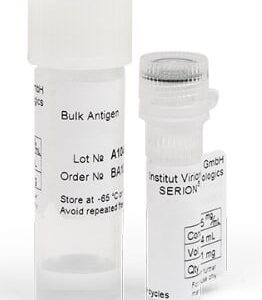| Weight | 1 lbs |
|---|---|
| Dimensions | 9 × 5 × 2 in |
| target | Coxiella burnetii phase II immunoglobulins |
| species reactivity | Coxiella burnetii (Q fever) |
| applications | ELISA |
| assay type | qualitative |
| available size | lyophilized |
Coxiella burnetii (Phase II) Positive Control Sample 3123
$75.00
Summary
- Virion/Serion Immunologics Antigen for research use (RUO)
- Cost-effective due to standardized reagents
- Lyophilized antigens, control antigens as well as positive and negative control sera simplify storage
- Suitable screening test to identify acute infections
- Compensation of seroprevalences allow high specificity
Coxiella burnetii (Phase II) Positive Control 3123
| kit |
|---|
| Research area Infectious Disease |
| Storage Store at -65°C. Avoid freeze/thaw cycles. Sonicate before use. |
| Associated products Coxiella burnetii Phase 2 IgG Control Serum (BC1312G) Coxiella burnetii Phase 2 IgM Control Serum (BC1312M) Coxiella burnetii IgA Phase I ELISA Kit (ESR1311A) Coxiella burnetii IgG Phase I ELISA Kit (ESR1311G) Coxiella burnetii IgG Phase II ELISA Kit (ESR1312G) Coxiella burnetii IgM Phase II ELISA Kit (ESR1312M) |
| target relevance |
|---|
| Organism Coxiella burnetii |
| Protein names Coxiella burnetii |
| Structure and strains Coxiella burnetii is an obligate intracellular bacterial pathogen, and is the causative agent of Q fever. The genus Coxiella is morphologically similar to Rickettsia, but with a variety of genetic and physiological differences. C. burnetii is a small Gram-negative, coccobacillary bacterium that is highly resistant to environmental stresses such as high temperature, osmotic pressure, and ultraviolet light. These characteristics are attributed to a small cell variant form of the organism that is part of a biphasic developmental cycle, including a more metabolically and replicatively active large cell variant form. It can survive standard disinfectants, and is resistant to many other environmental changes like those presented in the phagolysosome. |
| Detection and diagnosis The diagnosis of Q fever is performed by the demonstration of specific antibodies directed against Coxiella burnetii. Due to variations in the lipopolysaccharide (LPS) structure on the surface of the pathogen, as the disease enters the chronic state, a serological differentiation of acute from chronic infections is possible. Due to the high sensitivity and specificity, the use of ELISA immunoassays is recommended by the World Health Organization (WHO). Following the regular course of an acute primary infection, specific IgM and IgG antibodies directed against the immunogenic phase 2 antigens can be demonstrated. IgG antibodies directed against phase 2 antigens often persist over several years. In the lead-up to a chronic infection, IgG and IgA antibodies directed against the phase 1 antigens appear, which are of diagnostic value particularly for the diagnosis of Q fever endocarditis |
Data
Publications
| pmid | title | authors | citation |
|---|---|---|---|
| We haven't added any publications to our database yet. | |||
Protocols
| relevant to this product |
|---|
| BA102R01 protocol |
Documents
| # | ||
|---|---|---|
| KL0076 | Safety Data Sheet | QC certificate |
Only logged in customers who have purchased this product may leave a review.












Reviews
There are no reviews yet.